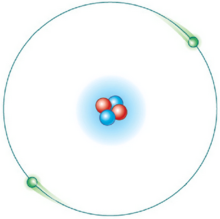Electron cloud
The electron cloud, atomic cloud or electron crust refers to the peripheral part of the atom, the region that surrounds the atomic nucleus and in which electrons are in permanent motion, in states described by atomic orbitals. Electrons have a negative electrical charge and are bound to the atomic nucleus by electromagnetic interactions. According to Quantum Mechanics, the electrons in their movement within the atom go through different zones, some with greater probability, which are determined by the shape and orientation of the atomic orbitals that describe each of the different electronic states. The superimposition of the regions of electronic density associated with the different orbitals forms the electronic cloud or periphery of the atom, with spherical symmetry, and which has a diameter some 10,000 times greater than that of the nucleus, which is why it practically represents the atomic radius. However, it has a mass considerably less than that of the atomic nucleus, where almost the entire atomic mass is concentrated. The atomic cloud is made up of an electron layer concentric electronic layers, whose number can vary from 1 to 7, and which are designated with the letters K, L, M, N, O, P and Q.
Contenido relacionado
Radiometer
Pauling scale
William S Knowles
